The Climb to Bald Knob
Comment via blog
Prev
Next


|
Day 3: July 1, 2017 The Climb to Bald Knob Comment via blog |
Prev Next |
 
|
|
|
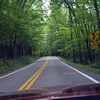 After a hearty breakfast at the inn, I took
a West Virginia beeline to Cass.
After a hearty breakfast at the inn, I took
a West Virginia beeline to Cass.
|
|
|
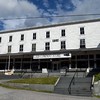
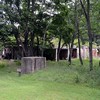
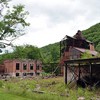
 The town of Cass is now owned by the state of West Virginia and has become
Cass Scenic
Railroad State Park. It is filled with white buildings including some
really big white buildings. I arrived with what I thought was enough time
to walk around the town and see more of those white buildings but learned
that a tour of the repair shop was available and decided the white
buildings could wait.
The town of Cass is now owned by the state of West Virginia and has become
Cass Scenic
Railroad State Park. It is filled with white buildings including some
really big white buildings. I arrived with what I thought was enough time
to walk around the town and see more of those white buildings but learned
that a tour of the repair shop was available and decided the white
buildings could wait.
I saw nothing at the place where I thought the tour was to start so walked toward the shop. The buildings I passed were all part of the huge sawmill that was once the town's reason for being. The mill closed exactly fifty-seven years ago, July 1, 1960. |
|
|

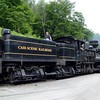

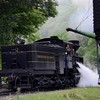 Before too long I was joined by two men who had also looked for and not
found the tour. As we wondered what we should do, we were treated to a
display of the locomotives that would be running today. The first two
pictures are of Shay No. 2 which will pull the train I'm riding to Bald
Knob. It began its career in 1928 on the west coast. It originally burned
wood, was converted to oil, and now runs on coal.
Before too long I was joined by two men who had also looked for and not
found the tour. As we wondered what we should do, we were treated to a
display of the locomotives that would be running today. The first two
pictures are of Shay No. 2 which will pull the train I'm riding to Bald
Knob. It began its career in 1928 on the west coast. It originally burned
wood, was converted to oil, and now runs on coal.
The second two pictures are of Shay No. 5 which has been operating in Cass since it was new in 1905. It will make two runs to Whittaker Station today. Typical steam locomotives have horizontal cylinders on both sides connected directly to drive wheels. Shay engines have vertical cylinders on the right hand side which are connected to a drive shaft running the length of the engine and driving all wheels. They are built for power not speed and were custom made, often literally, for logging. |
|
|
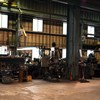
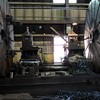

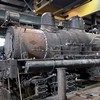

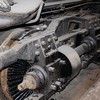 Keeping century old steam locomotives and other gear operating isn't at
all easy. Parts cannot be ordered from Pep Boys or Amazon. When something
breaks its replacement must be stripped from another machine or made from
scratch. There is a full machine shop at Cass and many of the metal
working machines in it have a name I recognize from more than a dozen
years at Cincinnati Milacron (nee Cincinnati Milling Machine Company).
Locomotives currently in the shop include the 1923 Shay No. 11 that worked
on the Pacific Coast and Shay No. 6 that was the last and largest Shay
ever built. It worked in Maryland.
Keeping century old steam locomotives and other gear operating isn't at
all easy. Parts cannot be ordered from Pep Boys or Amazon. When something
breaks its replacement must be stripped from another machine or made from
scratch. There is a full machine shop at Cass and many of the metal
working machines in it have a name I recognize from more than a dozen
years at Cincinnati Milacron (nee Cincinnati Milling Machine Company).
Locomotives currently in the shop include the 1923 Shay No. 11 that worked
on the Pacific Coast and Shay No. 6 that was the last and largest Shay
ever built. It worked in Maryland.
|
|
|
 We finished the tour and got back to the station in time to see Shay No.5
take off with its load of passengers. A short video of the departure is
here.
We finished the tour and got back to the station in time to see Shay No.5
take off with its load of passengers. A short video of the departure is
here.
|
|
|
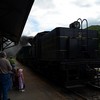
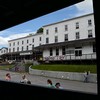
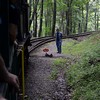

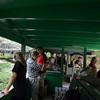 Then Shay No. 2 pulled a string of empty cars to the station and it was
our turn. We came to the first of two switchbacks little more than two
miles into the trip. The main purpose of switchbacks is to allow trains
to gain elevation in limited space but they also provide a way for trains
to pass one another. Here we pass the Shay No. 5 train returning from
Whittaker Station.
Then Shay No. 2 pulled a string of empty cars to the station and it was
our turn. We came to the first of two switchbacks little more than two
miles into the trip. The main purpose of switchbacks is to allow trains
to gain elevation in limited space but they also provide a way for trains
to pass one another. Here we pass the Shay No. 5 train returning from
Whittaker Station.
|
|
|

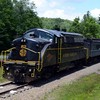
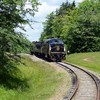

 Wonderful scenery and various trackside items provide plenty of things to
look at but I had not expected to see another train. Back at the station I
had noticed a couple checking a suitcase which made no sense to me at the
time. Now, with an explanation from the narrator, it did. The other train
came from the town of Elkins about 35 miles away. It's pulled by an
EMD BL2 built in the late 1940s. Passengers changed trains with a
walk along the gravel path between the tracks while workers delivered
bag lunches carried by the Elkins train.
Wonderful scenery and various trackside items provide plenty of things to
look at but I had not expected to see another train. Back at the station I
had noticed a couple checking a suitcase which made no sense to me at the
time. Now, with an explanation from the narrator, it did. The other train
came from the town of Elkins about 35 miles away. It's pulled by an
EMD BL2 built in the late 1940s. Passengers changed trains with a
walk along the gravel path between the tracks while workers delivered
bag lunches carried by the Elkins train.
|
|
|
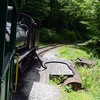


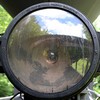
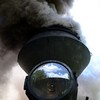 A short distance later we paused to take on water and many took advantage
of the stop to eat lunch. I took advantage of it to grab some photos of
the non-moving locomotive and I was in position to see the smoke start
bellowing out when the time to leave neared.
A short distance later we paused to take on water and many took advantage
of the stop to eat lunch. I took advantage of it to grab some photos of
the non-moving locomotive and I was in position to see the smoke start
bellowing out when the time to leave neared.
|
|
|
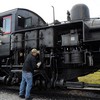
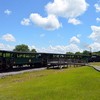
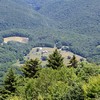
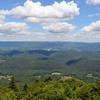
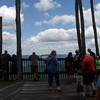
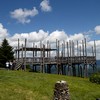 This is our destination, Bald Knob. There are stunning views along with
restrooms and some picnic tables one of which is where I ate most of my
lunch. The cookies I saved to munch on the ride down. I still had a little
time to stroll around and managed a picture of almost all of our train.
Oiling steam engines is never ending.
This is our destination, Bald Knob. There are stunning views along with
restrooms and some picnic tables one of which is where I ate most of my
lunch. The cookies I saved to munch on the ride down. I still had a little
time to stroll around and managed a picture of almost all of our train.
Oiling steam engines is never ending.
|
|
|
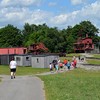

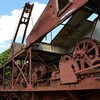 We had passed by Whittaker Station, the destination for shorter
excursions, on the way up but now made our own stop. On the way up, the
narrator had pointed out the various points where a skidder had once been
and explained how they used cables to drag logs to a central location to
be loaded onto a train. A reconstructed skidder sits beside the fire tower
at Whittaker Station. I walked to, around, and on it and still have no
idea of how it worked.
We had passed by Whittaker Station, the destination for shorter
excursions, on the way up but now made our own stop. On the way up, the
narrator had pointed out the various points where a skidder had once been
and explained how they used cables to drag logs to a central location to
be loaded onto a train. A reconstructed skidder sits beside the fire tower
at Whittaker Station. I walked to, around, and on it and still have no
idea of how it worked.
|
|
|
 Our last stop before reaching the station was at the old water tank.
Our last stop before reaching the station was at the old water tank.
|
|
|
| [Prev] [Site Home] [Trip Home] [Contact] [Next] |